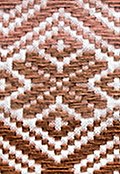References
- 1 2 Wingate, Isabel Barnum (1979). Fairchild's dictionary of textiles. Internet Archive. New York : Fairchild Publications. p. 299. ISBN 978-0-87005-198-2.
{{cite book}}: CS1 maint: publisher location (link) - 1 2 "Definition of HUCKABACK". www.merriam-webster.com. Retrieved 2021-04-26.
- ↑ Chisholm, Hugh, ed. (1911). . Encyclopædia Britannica . Vol. 13 (11th ed.). Cambridge University Press. p. 848.
- ↑ Barve, V. R. (1967). Complete Textile Encyclopaedia. D. B. Taraporevala Sons. p. 177.
- 1 2 Marketing Research Report. U.S. Department of Agriculture. 1952. p. 19.
- ↑ Skeat, Etym. Dict. (1898), says, “The word bears so remarkable resemblance to Low Ger. hukkebak, Ger. huckeback, pick-a-back, that it seems reasonable to suppose that it at first meant ‘peddler’s ware.’ ” The New English Dictionary does not consider that the connexion can at present be assumed.
- 1 2 Revenue, United States Bureau of Internal (1934). Internal Revenue Bulletin: Cumulative bulletin. U.S. Government Printing Office. p. 478.
- ↑ The English Cyclopedia. 1867. p. 295.
- ↑ Tams, Jeanne; Duffin, Nan (1998). Avery Hill's 33 contemporary Swedish weaving patterns for monk's cloth. Internet Archive. Layton, Utah : Avery Hill. p. 7. ISBN 978-1-929582-00-6.
- ↑ Farstad, Edmund Harry; Brensike, Valentine John (1952). Costs of Retailing Meats in Relation to Volume. U.S. Department of Agriculture, Bureau of Agricultural Economics. p. 19.
- ↑ Good Housekeeping. C.W. Bryan. 1888. p. 189.
